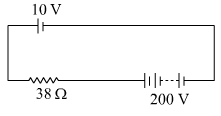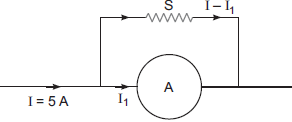 Short Answer Type
Short Answer TypeWhat is the geometrical shape of equipotential surfaces due to a single isolated charge?
A capacitor has been charged by a dc source. What are the magnitudes of conduction and displacement currents, when it is fully charged?
A 10 V battery of negligible internal resistance is connected across a 200 V battery and a resistance of 38  as shown in the figure. Find the value of the current in circuit.
as shown in the figure. Find the value of the current in circuit. 
State Lenz’s Law. A metallic rod held horizontally along east-west direction, is allowed to fall under gravity. Will there be an emf induced at its ends? Justify your answer.
A convex lens of focal length 25 cm is placed coaxially in contact with a concave lens of focal length 20 cm. Determine the power of the combination. Will the system be converging or diverging in nature?
An ammeter of resistance 0.80 can measure current upto 1.0A.
(i) What must be the value of shunt resistance to enable the ammeter to measure current upto 5.0A?
(ii) What is the combined resistance of the ammeter and the shunt?
(a) An em wave is traveling in a medium with a velocity . Draw a sketch showing the propagation of the em wave, indicating the direction of the oscillating electric and magnetic fields.
(b) How are the magnitudes of the electric and magnetic fields related to the velocity of the em wave?A capacitor of unknown capacitance is connected across a battery of V volts. The charge stored in it is 360 C . When potential across the capacitor is reduced by 120 V, the charge stored in it becomes 120 C .
Calculate:
(i) The potential V and the unknown capacitance C.
(ii) What will be the charge stored in the capacitor, if the voltage applied had increased by 120V?
OR
A hollow cylindrical box of length 1m and area of cross-section 25cm2 is placed in a three dimensional coordinate system as shown in the figure. The electric field in the region is given by, where E is in NC-1 and x is in metres. Find:
(i) Net flux through the cylinder.
(ii) Charge enclosed by the cylinder.